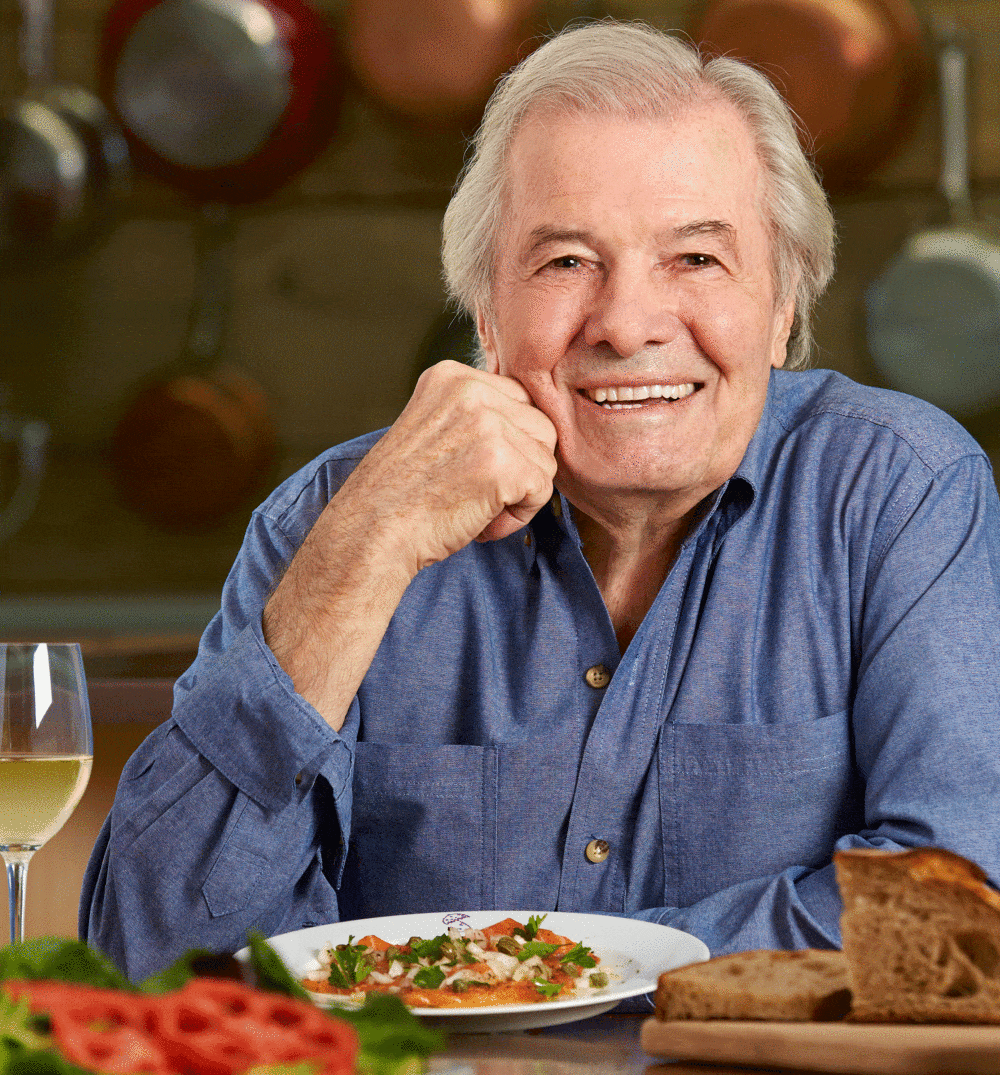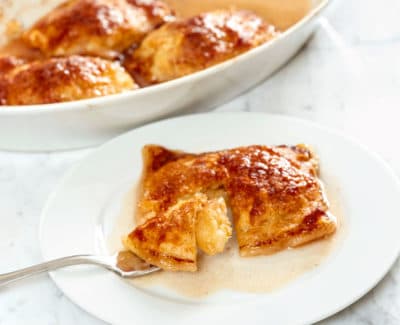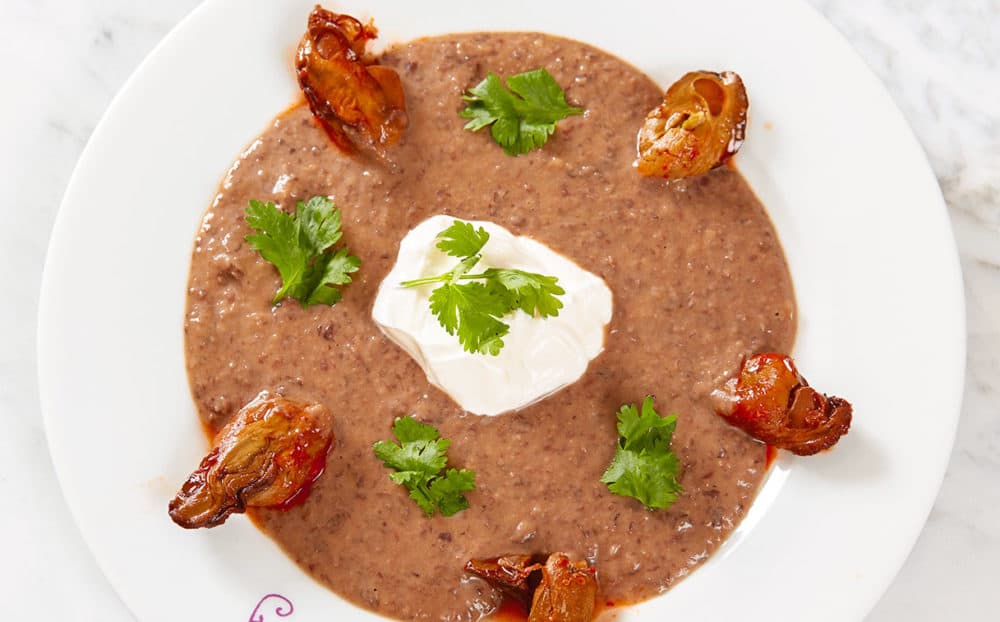Advertisement
Tired Of Pandemic Cooking? Jacques Pépin Says To Simplify, Shares His Best Tips

Food purists take note: A new cookbook says it's okay to use a food processor to make a baguette with no kneading, instant vanilla pudding in a Bavarian cream and even a bag of mixed frozen vegetables in a vegetable stew.
Who is saying all this? Well, it's none other than French food icon, 24-time James Beard Award winner, author, teacher, artist and chef Jacques Pépin. His new cookbook "Quick and Simple" provides not only a vast array of new recipes but also advice on how to make cooking easier.
With more than 30 cookbooks under his belt, Pépin says he could still write a book with 10,000 chicken recipes alone. Now 85 years old, he says he’s boiling down many of the recipes he created as a young chef down to the essentials.
"Quick and Simple" tells readers how to make a “cheese mishmash” by putting old pieces of cheese in a food processor with white wine and garlic to put on crackers. Or combine the crumbles with sunflower seeds, cranberries, honey and lemon juice for a nice puree.
“The point is that I have probably 30 recipes that I can do with leftover cheese,” he says.
In the book, he also preaches that it's okay to let someone else do some of your prep by using prewashed greens and canned or frozen foods.
To simplify cooking, short cuts such as using frozen pie crusts can work depending on the recipe. One great canned recipe combines black beans, smoked oysters, garlic, sesame oil, red wine vinegar and sour cream to make black bean hummus with smoked oysters.
In Pépin’s pantry, he keeps cans of beans, different kinds of tomatoes, sardines and tuna. For Thanksgiving, he makes a “beautiful” pumpkin gratin with a can of pumpkin, a cup of light cream, Swiss cheese and a few eggs.
His "Quick and Simple" French baguette recipe instructs readers to make the bread using a food processor and a single bowl. A two or three times proofed baguette made overnight will taste better, he says, but this easy recipe also tastes good.
Never waste bread, he says. Run leftover bread under water and put it in the oven for 10 minutes to bring back its crunch, or use it to make croutons or breadcrumbs.
Advertisement
During the few minutes it takes for your oven to reach 425 degrees, Pépin suggests preparing an Irish soda bread with flour, salt, water and baking powder.
“Your oven is not even at 425 and your bread is ready to go into the oven,” he says. “It's very good, too.”
When the late Julia Child, a friend of Pépin, lived in New England, Here & Now host Robin Young expected a grand meal when filming a segment with Child. But instead, Child pulled out a bottle of mayonnaise and made tuna sandwiches. Don’t make your own mayonnaise, Child warned, because Hellmann’s is the best.
“And on the other hand, Julia's recipe for baguette was like 12 pages,” he says. “Sometimes you can do one way, sometimes you do it another way.”
But with cooking, what matters is sharing a meal and conversation with family, he says. Pépin has been married for 54 years and sits down every night to share a meal and bottle of wine — or two — with his wife. Chicken, string beans, cheese and a big salad comprised a recent dinner in their home.
A few days ago, Pépin says his wife called to tell him a friend was coming for lunch. From the market, he bought a rotisserie chicken and a big head of lettuce. He sauteed garlic and onion in a skillet, sprinkled it on top of the cut chicken with some lemon juice, and put it on top of a salad.
Since the COVID-19 pandemic began in March, Pépin has posted 160 three-minute simple recipes on Facebook to show people how to use leftovers and what’s in their freezer or pantry.
“And for someone who has never cooked, if you do something very easy like this, it brings them into cooking and they become more confident and they will do it more,” he says.
Many people consider him “the quintessential French chef,” he says, but this book contains recipes such as black bean soup with banana and cilantro, Southern fried chicken and New England clam chowder.
“After over 60 years in America, I am probably the quintessential American chef now,” he says.
With scallops, Pépin says to poach them in two tablespoons of water and don’t turn them too early. He also cooks other fish such as salmon this way: in a cold skillet on full heat with the skin side down, salt and pepper and a lid on top for five to six minutes.
“It's a simple way to cooking,” he says. “And, you know, that's what you have to tell people.”
Karyn Miller-Medzon produced and edited this interview for broadcast with Todd Mundt. Allison Hagan adapted it for the web.
Recipes From 'Quick And Simple'
Processor Baguettes With Bran
Makes 4 baguettes
I love to make bread but sometimes don’t have time to prepare it in the conventional way. This dough, made in a food processor, is easy and gives terrific results. The dough is not kneaded by hand and doesn’t even touch the work table, so there isn’t much cleanup involved, which suits me fine. I have a large plastic bowl with a tight-fitting lid that I use for letting the dough rise, and I use this same bowl beforehand for measuring the flour. So, when I finish this recipe, all I have to wash are the food processor bowl and steel blade, and the plastic bowl. I oil the bowl, which makes cleanup easier, and since the dough retains a little of that oil, it doesn’t stick to the baking sheet.
If the air is dry, the dough will tend to form an outer skin or crust while it is rising, especially during the second rise. To prevent this, either spray the baguettes a few times with water while rising (I use a standard plant sprayer for this), or slide the baking sheet with the baguettes into a large plastic bag, taking care to prevent them from coming into contact with the bag and sticking to it as they rise.
In professional bread-baking ovens, steam is automatically injected into the oven at the beginning of the baking time; this gives the bread a thick, strong crust. To imitate this situation, I spray about 2tablespoons of water into the oven when I first put the bread in, and then repeat this a few minutes later.
If you like, you can partially bake the baguettes—creating “brown and serve” loaves—and then finish baking them later. Securely wrapped in plastic, the partially baked loaves will keep in the refrigerator for 3 or 4 days or in the freezer for weeks. When you are ready to eat them, all you have to do is moisten them lightly and bake them until they are brown and crusty.
I added bran to this recipe to create a type of whole wheat bread; if you prefer, you can add cracked wheat instead.
Ingredients
- 3 cups tepid water
- Two 1/4-ounce envelopes active dry yeast
- 1 teaspoon sugar
- 5 cups (1½ pounds) organic bread flour, also called strong or winter flour
- 1 cup (2 ounces) wheat bran
- 2 teaspoons salt
- 2 teaspoons peanut oil
- 2 tablespoons cornmeal
- About 1/4 cup water in a spray bottle
Instructions
Place the tepid water in a food processor and sprinkle the yeast and sugar over it. Let proof for 5 minutes.
Measure the flour, bran, and salt into a large bowl and add the mixture to the processor bowl. Process for 1½ to 2 minutes, holding the base of the machine to prevent it from “walking” on the counter. The dough should have formed a ball at this point.
Oil the bowl you used for the flour mixture with the peanut oil and transfer the ball of the dough to the bowl. Cover and allow to rise at room temperature for about 1½ hours, until the dough has doubled or tripled in bulk.
When the dough is ready, pull it away from the sides of the bowl and push it down into the bowl, forming it into a ball. Line a heavy aluminum cookie sheet that measures about 14 by 18 inches with nonstick aluminum foil. Place the ball of dough on the sheet and press down on it until it is about 8 inches wide and about the length of the cookie sheet. Cut the rectangle of dough into 4 lengthwise strips and arrange them on the cookie sheet so that they are equidistant from one another. Sprinkle the baguettes with half the cornmeal, then turn them over and sprinkle with the remaining cornmeal. Set aside for about 45 minutes. Spray (or sprinkle or brush) the dough with water if it begins to form a dry crust as it rises.
Place a rack in the middle of the oven and preheat the oven to 425 degrees. Using a serrated knife, cut 4 or 5 gashes 1/4 to ½ inch deep on a slight diagonal across the top of each baguette, or cut one long gash down the center of each. Place the cookie sheet on the middle oven rack and immediately spray about 2 tablespoons of water into the oven before closing the door. After 3 or 4 minutes, repeat the procedure.
If you are baking the bread completely, continue baking it for 30 to 35 minutes, until the loaves are brown and crusty. Remove and cool on wire racks. Serve warm or at room temperature.
If the bread is to be partially baked, remove the loaves from the oven after about 12 minutes, when they will have reached their ultimate size. (They will still be whitish at this point.) Cool completely, then wrap securely in plastic wrap and refrigerate for 3 or 4 days or freeze for up to 3 weeks. When you are ready to finish baking them, pass the frozen or refrigerated loaves under cool tap water to moisten them lightly all over. Arrange the loaves on a cookie sheet and bake in a 425-degree oven for 12 to 14 minutes, until nicely browned and crusty. Remove and cool on wire racks. Serve warm or at room temperature.
NOTE: Good bread dough is made with high-gluten (high-protein) flour, water, yeast, and salt. You can find good-quality packaged fresh or frozen pizza dough in most supermarkets. Fresh dough is ready to bake right away; frozen dough, which has a substantially longer storage life, is ready to use with very little advance notice—it thaws in a few hours in the refrigerator or in an hour or so at room temperature.
Bartlett Pears In Puff Pastry

Serves 6
For this easy dessert, I cover pear halves with frozen puff pastry and serve them right in the gratin dish in which they are baked. You can use apples instead of pears, if you prefer.
Ingredients
- 6 tablespoons sugar
- 3/4 teaspoon ground cinnamon
- 3 large ripe Bartlett pears (about 8 ounces each)
- 3 tablespoons lemon juice
- 1 sheet frozen puff pastry (about 8 ounces; ½ package), partially defrosted
- 2 tablespoons unsalted butter, softened
- 1/3 cup water
- Crème fraîche or sour cream, for serving (optional)
Instructions
Preheat the oven to 375 degrees. Mix the sugar and cinnamon together and set aside.
Peel the pears and cut them lengthwise in half. Remove the core from each half and arrange the pear halves cut side down in one layer in a gratin dish. Sprinkle with the lemon juice and half the cinnamon-sugar mixture.
Unfold the sheet of puff pastry and cut it apart at the seams to get 3 pieces approximately 10 inches by 3 inches. Cut each of these crosswise in half to create 6 pieces. Lay a pastry piece on top of each pear half, and as the pastry starts to defrost a little more and relax slightly, press the pieces gently around the pears so they take on the shape of the pear halves. Spread the butter on the pastry and sprinkle the remaining cinnamon-sugar mixture on top.
Place the gratin dish on a cookie sheet and bake for about 30 minutes, until the pastry is browning nicely and the juices around the pears are bubbling and caramelized.
Pour the water around the pears and return them to the oven for 5 minutes. The water will melt the caramel and create a sauce. Serve the pears warm, with crème fraîche or sour cream, if desired.
Black Bean Hummus With Smoked Oysters And Sour Cream

Makes 2 cups (6 servings)
This interesting variation on traditional Middle Eastern chickpea hummus was inspired by the black bean purees found in Mexico. Served with sour cream and smoked oysters, it makes an exciting dish.
I use canned black beans, but of course you can cook your own, which will tend to be darker than the canned variety. This is also good made with red kidney or other types of beans. I suggest serving it as a first course, but it can also be served as a dip with corn chips or Melba or other toasts.
Ingredients
- One 16-ounce can black beans
- 3 cloves garlic, peeled and crushed
- ¹⁄³ cup oil, preferably half olive oil and half walnut or peanut oil
- 1 tablespoon toasted sesame oil
- 1 tablespoon red wine vinegar
- 1 teaspoon Tabasco sauce
- ½ teaspoon salt
- 2 tablespoons coarsely chopped cilantro, plus whole leaves for garnish
- 1 cup sour cream
- Two 33/4-ounce cans smoked oysters (about 30)
- Toast triangles or Melba toast, for serving
Instructions
Drain the black beans in a sieve and place them in a food processor, along with the garlic. Process until the garlic is finely chopped and the mixture is smooth. Add the oils, vinegar, Tabasco, and salt and process for another 5 to 10 seconds to blend. Transfer to a serving bowl and stir in the chopped cilantro. Cover and refrigerate until ready to serve.
At serving time, spoon about ¹⁄³ cup of the hummus onto each of six plates and spread it out in the middle of the plate. Place a generous spoonful of sour cream in the center and top with cilantro leaves. Arrange the oysters around the hummus, dividing them evenly. Serve the toasts alongside.
Excerpted from JACQUES PÉPINQUICK & SIMPLE© 2020 by Jacques Pépin. Photography © 2020 by Tom Hopkins. Reproduced by permission of Houghton Mifflin Harcourt. All rights reserved.
This segment aired on October 13, 2020.

